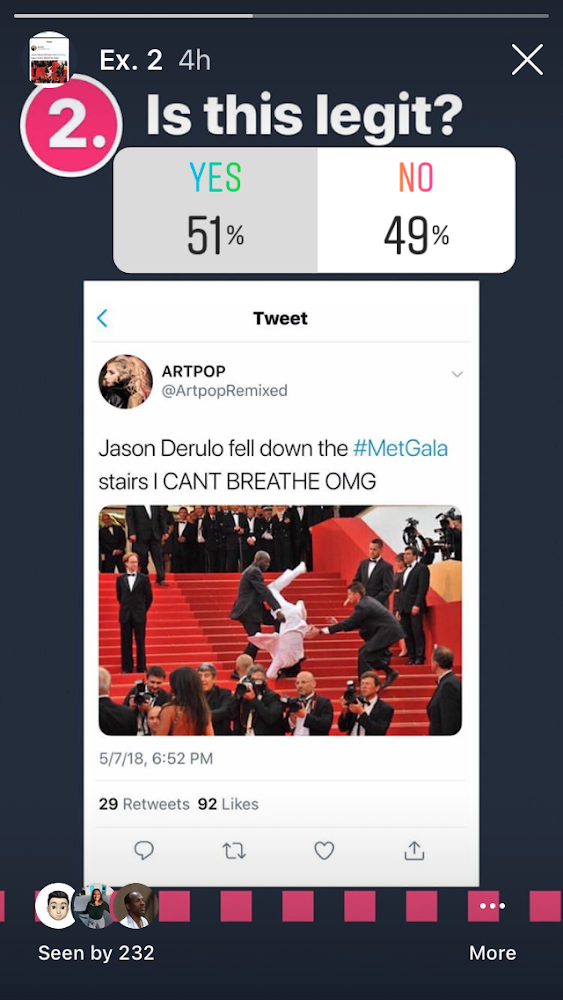Editor’s Note: Katy Byron is the Editor and Program Manager of MediaWise at The Poynter Institute for Media Studies. MediaWise is part of the Google News Initiative and is a Google.org funded partnership between The Poynter Institute, the Stanford History Education Group (SHEG), the Local Media Association (LMA) and the National Association for Media Literacy Education (NAMLE). Mediawise aims to teach one million students how to discern fact from fiction online by 2020.
Misinformation is nothing new, but in the digital age, it can spread like a virus. This is especially true for teenagers growing up with mobile phones as an extension of how they engage with the world and their friends. You might think teens are more digitally savvy, but research shows they can just as easily be fooled by misleading online content.
MediaWise helps teens figure out what’s real and what’s not by teaching them fact-checking skills that professional journalists use. I like to think of it this way: if misinformation online is a disease, then MediaWise is the Red Cross. Our work is based on a curriculum the Stanford History Education Group is currently writing and testing, which will be available for any middle school and high school teachers to download online for free this fall.
To kick off the new year, we spoke to 2,000 students and teachers at three schools in Houston, while 3,000 more watched online in class. We introduced them to tools like Reverse Google Image Search to help fact check the origin of a photo, shared tips and tricks on what to look out for, and heard from students and teachers about their concerns and experiences.
MediaWise reporters Allison Graves and Hiwot Hailu teaching the sophomore class at Spring Woods High School on January 9.
At Memorial High School, we spent the day with more than 600 students and had them do their own fact-checking online, using real-world examples of posts (like this one and this one) on social media. They voted through a live Instagram poll on whether or not they thought a post was legit. Most got the first few examples wrong, but as their fact checking skills improved, got more right.
And at Spring Forest Middle School, less than half the 8th grade class of 300 students could tell whether a viral photo claiming Jason Derulo falling down the stairs at the Met Gala was fake. Afterwards, students said they’ll do more research before sharing information online and felt these skills should be taught in all classrooms by their teachers.

MediaWise wants students to lead this work themselves. Last week, we launched theMediaWise Teen Fact-Checking Network: a stellar crew of 24 students from across the country ranging from 15 to 18 years old. They’ll create original fact-checking videos for YouTube,Instagram, Facebook and Twitter to help us reach our target teen audience.
MediaWise multimedia reporters Allison Graves and Hiwot Hailu are leading this squad and guiding them on our quest to “fact-check the Internet.” This crew is the real deal—many work for their high school newspaper or TV station. Madeleine Katz, a 16-year-old from St. Petersburg, Florida with a popular Instagram account reviewing young adult books, joined because she feels strongly about the mission to empower her generation to be informed decision makers. Yasmeen Saadi from Kansas joined because she thinks it’s hard for teens to determine real from fake news on the internet.
MediaWise also partnered with best-selling author John Green to create a 10 part series on his CrashCourse YouTube channel called Navigating Digital Information, which launched last week. Each episode is chock-full of fact-checking tips and tricks and gives a sneak peek into the curriculum that will be available in the fall.
Teens want to learn how to discern fact from fiction online and teachers want new tools to help them teach their students to be smarter consumers of information. If your school is interested in MediaWise, or you want to be a part of the Teen Fact Checking Network, we’d love to hear from you. Check out our website to learn more and if you see something suspect online, tag us on social media with #isthislegit and our handle @MediaWise and we’ll check it out.
Source : Helping teens root out misinformation and get media savvy











